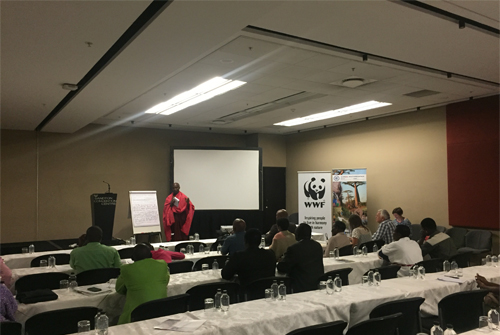Communities Day at CITES: an alternative conservation voice
By Clara Bocchino
Community representatives from Africa and other countries voiced their concerns at the recently concluded CITES CoP17 over the current conservation strategies, which affect rural communities, their lives and livelihoods. The ultimate objective was to resolve the everlasting impasse between fortress conservation and sustainable use models by finding a common ground between people and conservation.
The following needs were clearly elucidated by Mr. Munzhedi, the Deputy Director General of the South African Department of Environmental Affairs:
- Institutional mechanisms in CITES to facilitate people voice.
- Modalities and systems defined for scientists and also directed to participants.
- Linking changes in Appendixes with socio-economic and community matters.
Maxwell Gomera stressed that current conservation issues are also about democracy and human rights, especially if linked to the Sustainable Development Goals. These points formed the basis of Rosie Cooney’s talk on decision-making processes that exclude people with a stake in conservation and natural resources management, by upscaling the space for decisions at the regional and international political level.
Then the voices began to be heard about how exclusive decision-making for conservation affects people living with wildlife. In South Africa, the point was reiterated that even through the land restitution process, people are not free to decide on land use options, but need to co-manage with government when wildlife is concerned. Elsewhere in the continent, where sustainable utilisation through trophy hunting is adopted as a management model, the incentives for communities to conserve are reducing dramatically because of bans on hunting and trophy exports. As hunting companies close down and eliminate the cash benefits to communities, poaching is rising in Tanzania. The history and experiences of the Canadian Inuit were an eye-opener for many, both in terms of the struggle ahead for community’s voices to be heard by their own governments and of the difficulties in reducing the influence of the international community on local species management and livelihood strategies.
 |
|
A Masaai speaker at the working group debate. Photo credit: Clara Bocchino. |
In the session facilitated by Dilys Roe, the point was made by the participants that human lives and subsistence agricultural production are threatened by wildlife encroachment. This is particularly relevant to the debate, because it pertains to the relationship between people, the state and property. The people are frustrated for poor institutional arrangements for people damaged if anyone destroys their property said a representative of the community near Liwonde National Park, Malawi. In Zimbabwe, some people from the Leba area near Gonarezhou National Park have relocated to Mozambique, and retaliated by becoming elephant poachers.
Namibia and Canada, having mostly resolved the national authority and decision-making situation, were able to articulate several important points:
- CITES tends to look for a one-size-fits-all solution which is not possible because range states should have a bigger voice;
- Culture and language become barriers in the international sphere because rural people cannot express themselves in their mother tongue, and perception is shaped by their appearance and/or ability to communicate in the right jargon;
- The costs of living with wildlife are not taken in serious consideration at the international level.
In the final session, facilitated by Julian Sturgeon, the participants were unanimous that the communities need mechanisms like CITES and the SDGs, as active participants in the discussions, decision-making and implementation. A notable point was made by a representative from Botswana, who stated that until it is firmly understood that, in terms of land rights, “nature and culture are indivisible” for rural communities across the world, there will always be conflict with the conservation policies at various levels.
Some other critical issues raised in this section were:
- The need for conservation to have a human face and resolve those socio-economic issues which are the main drivers for wildlife crimes;
- The need for conservation to have a human face and promote the respect of human rights for rural communities globally, instead of becoming more militarised;
- The need for wildlife to become a legitimate land use through a mixture of protection and utilisation with local planning and management solutions, not a one-size-fits-all programmatic framework.
The meeting concluded with a summary made by Holly Dublin, and the participants drafting a way forward to get organised at national and international levels, and the promise that the organisers will continue to support the process. The next appointment would be the Convention of Biological Diversity Conference of the Parties in Cancun, Mexico.
[1] Director of the United Nations Environment Programme’s Biodiversity and Ecosystems Branch.
[2] Chair of the IUCN Commission on Environment, Economy and Social Policy/Species Survival Committee - Sustainable Use and Livelihoods Specialist Group
[3] Dilys Roe is the Principal Researcher and Team Leader for Natural Resources at the International Institute for Environment and Development.
[4] Julian Sturgeon is the Executive Director of Resource Africa.
[5] Holly Dublin is the Chair of the IUCN African Elephants Specialist Group.
Clara Bocchino is Faculty of Law, North West University, Potchefstroom Campus (RSA) and co-organizer to the event.